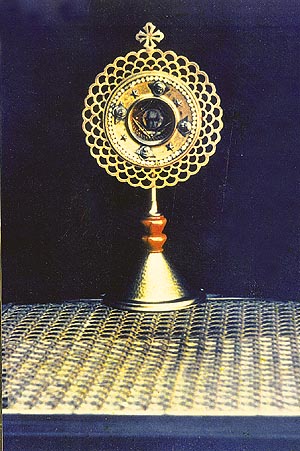 |
| Saturday, April 22, 2000 |
|
 |
The Indian apostolic tradition avers that St. Thomas made two voyages to India for his evangelical work. The first visit was in AD 52. He finally came to the Hindu temple-town of Mylapore (City of Peacocks) near modern Chennai and was martyred in AD 68 , writes K.R.N. Swamy AMONG the Apostles of Christ, St. Thomas — on account of his desire for empirical knowledge — stands out as the all-too-human disciple so much so that the Master had to chide him for his lack of faith. It was St. Thomas who, during the discourse before the Last Supper, raised an objection: "Lord...we know not whither thou goest and how can we know the way?" When the other Apostles announced Christ’s Resurrection to him, Thomas answered: "Except I shall see in his hands the print of the nails, and put my finger into the place of the nails, and put my hand into his side. I will not believe." Of course, eight days later, he made his Act of Faith, but the epithet "Doubting Thomas" has stuck. |
 St. Thomas has a link with India. The
mission of St. Thomas to the Court of King Gondophernes,
as described in the Acts of St. Thomas, is associated
with the coming of Christianity in India. The Acts of St.
Thomas are divided into nine parts, of which the first
eight are known as Acts and the last is called The
Consummation of Judas Thomas. The first Act is
entitled The Act of Judas Thomas the Apostle. It
mentions that Jesus Christ willed that he be sold to the
merchant Habban, so that he might go down and convert
Indians. St. Thomas protested, saying: "I have not
the strength enough for this, because I am weak. And I am
a Hebrew, how can I teach the Indians?" Then Jesus
Christ appeared to him in a vision and told him,
"Fear no Thomas, because my grace is with
thee". The Indian apostolic tradition avers that St.
Thomas made two voyages to India for his evangelical
work. The first visit was in AD 52. He finally came to
the Hindu temple-town of Mylapore (City of Peacocks) near
modern Chennai and was martyred in AD 68 by the local
priests who found his activities inimical to Hinduism.
Some sections of Hindus aver that killing a man of God,
even belonging to a foreign religion, is unheard of in
Hinduism which shows toleration for other faiths, and
that the Saint appears to have been accidentally killed
by a hunter, who was looking for peacocks in the forest.
According to local Christian tradition, St. Thomas is
said to have hidden himself in a cave near the 300
foot-high hill (known as St. Thomas’s Mount). He was
pursued to the cave by his opponents and the Saint
escaped ‘miraculously" through a narrow fissure
in the rock-walled cave. Indentations in the stone cave
are pointed out as the handprints of St. Thomas and the
narrow opening (hardly big enough to allow a cat to slip
through) is now closed with trellis work. It is believed
that after leaving the cave, the Saint went to the shrine
he had erected on the mount and the assassins killed him
there with a lance. The Apostle died clasping the cross
he had carved on stone in the shrine. This cross is
believed to be the one at the altar of the Church of Our
Lady of Expectation on the St. Thomas Mount in Chennai. St. Thomas has a link with India. The
mission of St. Thomas to the Court of King Gondophernes,
as described in the Acts of St. Thomas, is associated
with the coming of Christianity in India. The Acts of St.
Thomas are divided into nine parts, of which the first
eight are known as Acts and the last is called The
Consummation of Judas Thomas. The first Act is
entitled The Act of Judas Thomas the Apostle. It
mentions that Jesus Christ willed that he be sold to the
merchant Habban, so that he might go down and convert
Indians. St. Thomas protested, saying: "I have not
the strength enough for this, because I am weak. And I am
a Hebrew, how can I teach the Indians?" Then Jesus
Christ appeared to him in a vision and told him,
"Fear no Thomas, because my grace is with
thee". The Indian apostolic tradition avers that St.
Thomas made two voyages to India for his evangelical
work. The first visit was in AD 52. He finally came to
the Hindu temple-town of Mylapore (City of Peacocks) near
modern Chennai and was martyred in AD 68 by the local
priests who found his activities inimical to Hinduism.
Some sections of Hindus aver that killing a man of God,
even belonging to a foreign religion, is unheard of in
Hinduism which shows toleration for other faiths, and
that the Saint appears to have been accidentally killed
by a hunter, who was looking for peacocks in the forest.
According to local Christian tradition, St. Thomas is
said to have hidden himself in a cave near the 300
foot-high hill (known as St. Thomas’s Mount). He was
pursued to the cave by his opponents and the Saint
escaped ‘miraculously" through a narrow fissure
in the rock-walled cave. Indentations in the stone cave
are pointed out as the handprints of St. Thomas and the
narrow opening (hardly big enough to allow a cat to slip
through) is now closed with trellis work. It is believed
that after leaving the cave, the Saint went to the shrine
he had erected on the mount and the assassins killed him
there with a lance. The Apostle died clasping the cross
he had carved on stone in the shrine. This cross is
believed to be the one at the altar of the Church of Our
Lady of Expectation on the St. Thomas Mount in Chennai.The body of the saint was buried by his followers in the little church he had built on the mount. Later, in the fourth century, a part of the Apostle’s remains were taken to the Church in Edessa, near the banks of the Euphrates in the Middle East. During the feudal ages, the relics were removed to Ortona on the Adriatic coast of Italy to save them from vandals. But even in the fourth century some of the bones and relics were left in the tomb on the Mount. They were recovered in July 1523. While rebuilding the ruined Church, the Portuguese found it necessary to open the tomb inside the sepulchre. They found a few bones with the sharp point of the spear with which the Apostle was killed, and an earthen vessels filled with blood-soaked sand. These relics are still kept in the vestry of San Thome Church in Madras. The finger with which the saint is said to have touched the wounds of the Risen Christ is preserved in the sanctum sanctorum in the Basilica of St. John Latern in Rome. A portion of this finger was gifted to India by the Vatican in 1952 while commemorating the 1900 anniversary of the saint’s visit to India and is now kept with other relics in San Thome Church. Another relic associated with St. Thomas is the Bleeding Cross of St. Thomas. It was recovered by the Portuguese in 1547 while digging the foundation for the new church and was embedded in the wall of the church in 1551. The cross is so called because until 1704, it shed small drops of blood usually on the December 18 (said to be the date of the saint’s martyrdom). — (MF) |